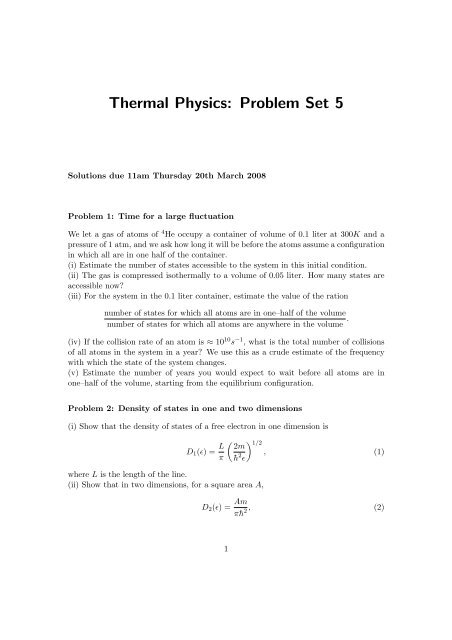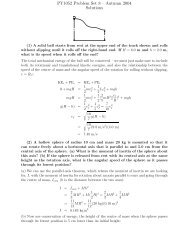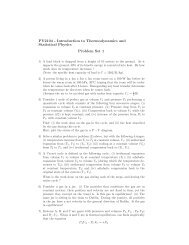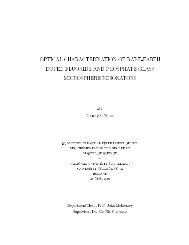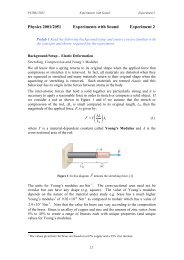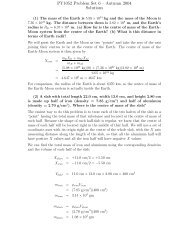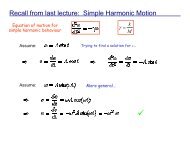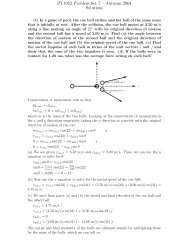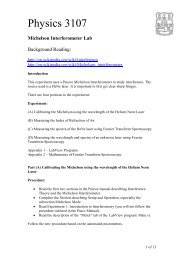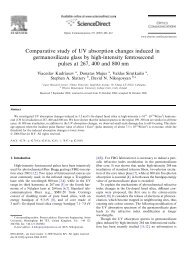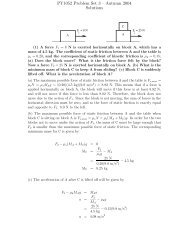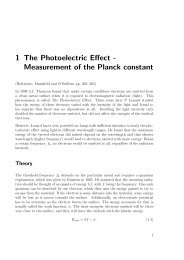Thermal Physics: Problem Set 5
Thermal Physics: Problem Set 5
Thermal Physics: Problem Set 5
You also want an ePaper? Increase the reach of your titles
YUMPU automatically turns print PDFs into web optimized ePapers that Google loves.
<strong>Thermal</strong> <strong>Physics</strong>: <strong>Problem</strong> <strong>Set</strong> 5Solutions due 11am Thursday 20th March 2008<strong>Problem</strong> 1: Time for a large fluctuationWe let a gas of atoms of 4 He occupy a container of volume of 0.1 liter at 300K and apressure of 1 atm, and we ask how long it will be before the atoms assume a configurationin which all are in one half of the container.(i) Estimate the number of states accessible to the system in this initial condition.(ii) The gas is compressed isothermally to a volume of 0.05 liter. How many states areaccessible now?(iii) For the system in the 0.1 liter container, estimate the value of the rationnumber of states for which all atoms are in one–half of the volumenumber of states for which all atoms are anywhere in the volume .(iv) If the collision rate of an atom is ≈ 10 10 s −1 , what is the total number of collisionsof all atoms in the system in a year? We use this as a crude estimate of the frequencywith which the state of the system changes.(v) Estimate the number of years you would expect to wait before all atoms are inone–half of the volume, starting from the equilibrium configuration.<strong>Problem</strong> 2: Density of states in one and two dimensions(i) Show that the density of states of a free electron in one dimension isD 1 (ɛ) = L πwhere L is the length of the line.(ii) Show that in two dimensions, for a square area A,( ) 2m 1/2¯h 2 , (1)ɛD 2 (ɛ) = Amπ¯h 2 , (2)1
which is independent of ɛ !<strong>Problem</strong> 3: Fluctuations in a Fermi gasShow for a single orbital of a fermion system that〈(∆N) 2 〉 = 〈N〉(1 − 〈N〉), (3)if 〈N〉 is the average number of fermions in that orbital. Notice that the fluctuationvanishes for orbitals with energies deep within the Fermi sea, so that 〈N〉 = 1. Bydefinition, ∆N = N − 〈N〉.<strong>Problem</strong> 4: Fluctuations in a Bose gasIf 〈N〉 = ∑ n f(ɛ n, τ, µ)N n , is the average occupancy of a single orbital of a boson system,then using 〈(∆N) 2 〉 = τ∂〈N〉/∂µ show that〈(∆N) 2 〉 = 〈N〉(1 + 〈N〉). (4)Thus, if the occupancy is large, with 〈N〉 ≫ 1, the fractional fluctuations are of theorder of unity: 〈(∆N) 2 〉/〈N〉 ≈ 1, so that the actual fluctuations can be enormous.2


